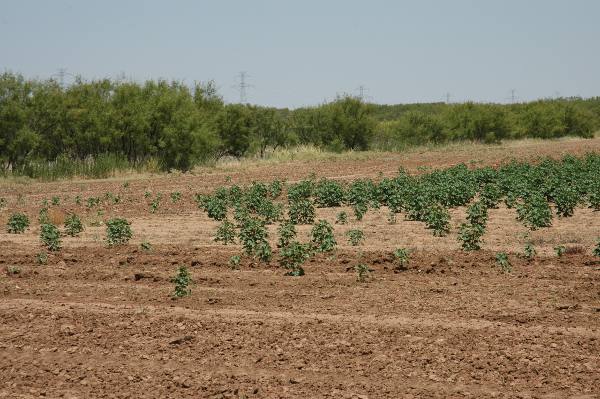
“Farming looks mighty easy when your plow is a pencil, and you’re a thousand miles from the corn field.” – President Dwight D. Eisenhower
It’s a week of milestones for agriculture across the Southwest, including the advent of the spring season (March 20) and observance of National Ag Day (March 19) and National Ag Week (March 17-23).
As the world population continues to soar, there is an even greater demand for food, fiber, and renewable resources, and the role of agriculture in our everyday lives is more than substantial, it is remarkable.
As farmers and ranchers across the Southwest welcome the start of the spring season with a degree of anxiousness, we are reminded that while we live in a time of advanced agricultural science and a world of high technology, the challenges of modern agricultural are as high as they have ever been.
In addition to a lengthy drought, producers are facing unprecedented herbicide-resistant weed varieties, historically significant input costs, growing issues with animal health and welfare, issues related to crop security, uncertainty about farm legislation and a changing farm environment, elevated land prices, potential climate change and serious issues of water availability.
The cost of available land is going up, concerns over competitive global markets are escalating and the need to be more productive with less land and water are increasing as demand for affordable food increases at an accelerated rate.
In the American Southwest agricultural tradition runs deep. Historians remind us that long before the first European set foot in the New World, the Anasazi and their predecessors were cultivating corn, squash, chili peppers and beans. In centuries to follow, great cattle ranches were established supplying a nation’s demand for beef. The Southwest led the way in sheep and mohair production and farms producing most every imaginable crop were established.
In modern times, a three-state region of the Southwest (Texas, Oklahoma and New Mexico) represented the largest contribution of beef cattle last year with no less than 18 million head, over 20 percent of the nation’s total herd. In addition, the total crop value in the three-state region totaled nearly $12 billion last year.
In addition to being the leader in cattle production, the region is a significant contributor to U.S. production of cotton, corn, grain sorghum, wheat, hay, peanuts, rice, soybeans, pecans, citrus, sheep, goats and mohair.
The number of farms in Texas alone totaled nearly a quarter million (247,523) with an average farm size of 527 acres. Average value per farm of all farm assets, including land and buildings, has increased from $20,100 in 1950 to $816,646 in 2009.
But while agriculture remains strong across the Southwest, it doesn’t come easy. At the top of the wish list for most producers in the region is the hope for substantial rain this season and throughout the year. Two years of continuous drought have taken a toll on the industry, and many producers are posting losses as a result.
Water woes
Also in the water arena, an ongoing dispute between the United States and Mexico over a 1948 water treaty adds to concerns that water will continue to be the number one roadblock to agricultural growth and sustainability in the years ahead. As if that wasn’t enough, even sister states Texas and New Mexico are arguing over water rights on the Rio Grande River, and Texas rice growers are headed into a second year of water curtailment as the City of Austin vies for more acre-feet of Colorado River water for urban use and development.
Because of its proximity to Mexico, animal and crop producers in both Texas and New Mexico are facing increased food security risks as animal and plant diseases filter across the international border, often at the hands of illegal traffickers. In addition, Southwest cattle producers, chili pepper growers, and fruit and nut producers are facing stiff competition from Mexican and other Latin American agricultural operations.
But beyond the problems and challenges of the industry, agriculture remains the backbone of the Southwest’s economy, and as we prepare for the spring equinox this week and celebrate National Ag Week, we are reminded to recognize and celebrate the abundance provided by farming and ranching efforts. Every year, agricultural associations, corporations, universities, government agencies and countless others across America join together to recognize the contributions of agriculture, and no one should be more proud of agriculture’s contributions and success than the men and women and families who make it happen at the grass roots level.
Agriculture provides almost everything we eat, use and wear on a daily basis. But too few people truly understand this contribution. National Ag Day and National Ag Week are designed to build awareness about the significance of the industry and how it affects every life in every nation of the world.
Each American farmer feeds more than 144 people—a dramatic increase from 25 people in the 1960s. Simply put, American agriculture is doing more—and doing it better every year. As the world population soars, there is an even greater demand for the food and fiber produced in the United States.
As we work our way into the new season and through this significant week, each of us should remember that we are part of a process that insures the health and welfare of all mankind. May we be bold and mindful to remind our family, friends and neighbors of the great service they receive from America’s oldest and most productive industry—agriculture.
Southwest Farm Press salutes the men, women and families that keep agriculture strong in America.
If you are enjoying reading this article, please check out Southwest Farm Press Daily and receive the latest news right to your inbox.
You may also like:
In the Valley, not just farmers, but cities, may run out water by spring
Advancing the frontier of sustainable agriculture in the Southwest
About the Author(s)
You May Also Like




